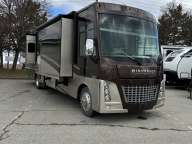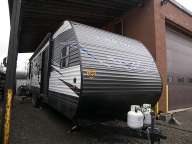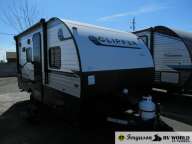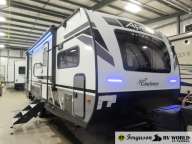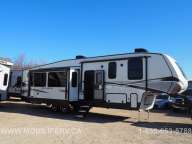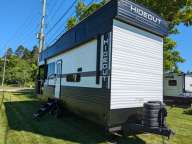TEN "Must-Haves" for Your New RV
Wednesday March 4th 2020
So you’ve just gotten a brand new RV and your family has headed out for an inaugural weekend getaway to celebrate. You show up at the campground, and the experience is not what you expect. You can’t seem to get your trailer quite level, and it feels like its shifting and rolling a bit every time you walk around in it. Your power cable won’t reach the shore power outlet, and you’re stuck effectively dry camping. The kids are having fun, but they keep tromping mud and leaves into the carpet of your brand new investment. You start wondering if all this trouble was even worth it.
Don’t despair! Some fore-thought and a little extra investment can save you tons of headaches on your first and future camping trips. You can’t know what every campsite will be like, so we’ve compiled a list of the eight things you need in order to be prepared for common, and even not-so-common challenges that can arise. Keep reading to see how you can make your first camping trip go just as smoothly as your fiftieth.
1. Tire Pressure Gauge & Torque Wrench
Wheel and tire maintenance is one of the most overlooked yet critical elements of RV ownership. Always torque wheel nuts to the wheel manufacturer’s specifications. Over or under-torqued wheel nuts can cause the wheel to separate from the wheel mounting surface during operation, causing property damage, personal injury, or loss of life.
Checking beforehand can avoid headaches or damage later. Your Keystone owner’s manual recommends you check your tire pressure and wheel lug nut torque before each trip. The owner’s manual will provide you with torque recommendations for your camper. Watch the short video here.
2. Wheel Chocks and Leveling Blocks
It’s pretty easy to level a trailer while it’s sitting on flat concrete. Things can get a little more difficult when you get out onto rough and uneven ground, like what your might find at many campsites. Leveling blocks (either homemade or store bought like these) help make that process much easier, especially if you don’t have an auto-leveling system. Use the blocks under your tires to get your trailer level side-to-side. Once your trailer or fifth wheel is level side-to-side, use wheel chocks to keep if from rolling or moving. Once the wheels are chocked in place, use the tongue jack on a travel trailer, or front jacks on a fifth wheel to level your trailer front to back. All level, now lower your scissor stabilizer jacks to steady the coach for camping. Your stabilizer jacks were not designed for leveling the coach and can get damaged if try to use them to level your trailer.
3. RV Power extension cord with adaptors
You won’t know the exact layout of your camp site until you are there. It is possible that the best position for your RV will not be within reach of the shore power outlet. Here’s where an extension cord that matches the power amperage of your main shore power cord comes in handy. Don’t forget various adaptors to make connecting to the power pedestal possible, like this adaptor that converts a 30AMP power cord to connect to a 15AMP shore power outlet.
4. RV Surge Suppressor with Built in Circuit Analyzer
You can’t know the state of a site’s electrical wiring before you arrive, and a surprise lightning strike could send a surge through that system. An RV surge suppressor with built in circuit analyzer can give you piece of mind that your appliances and electronics are protected.
These devices that attach to your RV’s power cable start at around $100. That sounds like a lot, until you realize that repairing a blown out refrigerator could cost many hundreds of dollars, and that doesn’t even take into account how the loss of your fridge could ruin a camping trip.
5. Water Pressure Regulator
Like we’ve been saying, you can’t know what the campsite will be like. When hooking up to your ‘city water’ connection, water pressure that is too high can damage your trailer’s pipes, leading to costly repairs. A water pressure regulator is a simple way to make sure you don’t blow out your pipes causing a messy, and costly, problem. Keystone recommends that water pressure entering your system not exceed 45 PSI.
6. Sewer Hose, Disposable Gloves, and Holding Tank Chemicals
Nobody feels comfortable talking about poop. We’re feeling a little weird even saying that and we’re just writing an article with nobody watching. A step by step walk-through of how to flush your black and grey tanks after your stay is over may not have been covered in your walk through. We’re not going to go over the specifics, but in order to complete the process cleanly and easily, you should have all these tools at the ready. Now let’s move on to something more fun.
7. Patio Mat & Camp Chairs
Nature is dirty. Your RV doesn’t have to be. A patio mat will help keep the mud and leaves outside, where it belongs and helps prevent stumbling over an exposed root or rock. As far as camp chairs go, we say the more the merrier (within the limits of your storage space, of course). Make sure you have enough seating for everyone who’s coming on the trip, and maybe a few more. You never know who you’ll meet while you’re camping, and you may want to invite them over to your site for s’mores, beers, or just lively conversation. It’s always nice to be able to say they don’t have to lug chairs with them when they come.
8. Non-toxic, drinking-water safe hose
Did your mom ever tell you not to drink from the water hose? She was probably right. Garden hoses aren’t designed with human consumption in mind and may leach harmful chemicals. You will want to invest in a non-toxic, drinking-water safe hose both to fill your fresh-water holding tank and to connect to your city water hook up when you are at a campsite that offers a fresh-water connection. We’ve found that a 50’ hose is about right, though you can certainly go longer.
9. Water FIlter
Outside Water Filters connect right to your RV at your Water Line connection. They can take out iron and rust particles, lime and scale, contaminants, sediment, turbidity, bad taste and foul odours.It must be noted that they don't take out bacteria. You would need a Water Purifier for that.
10. Maxxair Vent Covers
These are covers for you vent lids, meant to allow you to keep your roof vent open at all times, even during the rain. You can keep them open even when you are driving. They allow moisture to leave your trailer and bring in fresh air.
Your camping experience is supposed to be relaxing and fun. You don’t want that to be disrupted by a problem that could have been prevented. You can get all these items at your local Keystone RV dealer before you hit the road.
10 TOP ITEMS YOU NEED


Nov 10, 2023
Dec 19, 2019
Jun 8, 2019
Aug 29, 2016
Jul 4, 2016






